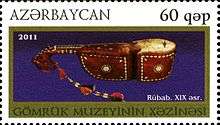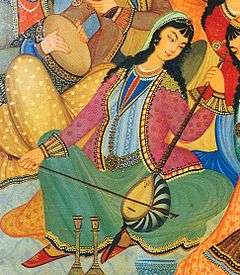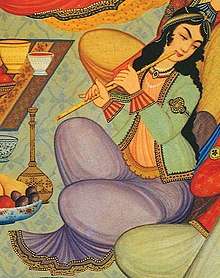Rubab (instrument)
 | |
| Classification | |
|---|---|
| Related instruments | |
| Sarod, Dutar, Tanbur | |
Rubab, robab or rabab (Urdu: رباب, Hindi: रुबाब, Azerbaijani: Rübab, Turkish: Rübab, Persian: رُباب rubāb, Tajik and Uzbek рубоб) is a lute-like musical instrument originating from central Afghanistan.[1] The rubab is mainly used by Pashtun, Tajik, Turkish, Kashmiri, Baluch, Azerbaijani, and Iranian Kurdish classical musicians. Rubab is one of the national musical instruments of Afghanistan.[2] It has "proliferated throughout West, Central, South and Southeast Asia."[3]
Etymology of the term Rubab, Rabab and Rebab
Rbab (Arabic: رباب) is an Arabic word. According to the Arabic diacritics, vowels between consonants - apart from Alif (Aleph) are not written but articulates. Harakat (movement = inflection of vowels) with Fatḥah similar to Acute accent Rabab (Arabic: رَباب, with Kasrah Rebab (Arabic: رِباب) and with Ḍammah Rubab or Robab (Arabic: رُباب . In context, the inflections and thus with respect to the meanings of words John Richardson has written in 1777 the first English-Arabic-Persian dictionary. Here are just a few meanings mentioned.[4][5] Rabab or Rubab as:
- a beautiful woman, contract, mirror, Persian instrument with a bow, long-necked lute.
- the name of the mother of Ali Asghar, a great-grandson of Mohammad
Since the introduction of the Arabic script in the main Iranian languages such as Persian, Pashto, Kurdish and Beluchi the original words are outdated for today's music instruments and are still only largely in dictionaries, et al listed by Thomas Hyde 50 Pharhang (Farhang is a Persian word meaning dictionary) in his major work, published in 1700 in Latin. In Latin writings before the time of Thomas Hyde terms like Persarum Pandura or Citara.
Ruwawah (Persian: رواوه), Rawadah (Persian: رواده), (Persian: شاشنگ) Shashang, Tar(Persian: تار), Saz (Persian: ساز) or Rud, long-necked lute have been used..[6][7][8]
The Arabic terms Rabab, Rabab, etc. have become established for the Iranian musical instruments. Even Rudaki has not made of Rubab use, Al Farabi anyway! The first poet of Persian literature and author of Shahnama, Firdoussi from Khorassan has many times the instrument Rubab used in his work.[9]But the European translator of Shahnama from Persian to German as Friedrich Rückert has the Proper nouns "Rubab" not adopted, but translates the name Rubab like lute, stringed lute, sound of Strings. Without exception, all Persian poet from Bach to India, from Kashgar to Iraq have written the name Rubab in their works.
Name of Rubab by size
- large: Shah Rubab شاه رباب (Persian: شاه رباب, King Size), 21 strings like, 15 sympathetic strings, Shahrud, Shahnai Ney in King Size, Shahtar (Large string). (see to Rubabnamah (Persian: رباب نامه) of Sultan Walad, son of Rumi from Balkh.
- medium-sized: Rubab (Persian: رباب), 19 strings, 13 sympathetic strings
- small-sized: Zaliche (Persian: زيلچه), 5 sympathetic strings
Rubab accordance with the construction
Seven forms of Rubab. The number seven has the Iranian cultural area of great importance Rubab has regularly twice bodies.In many varieties the double-Corpus are close to each other, in some has moved away and again for some is just a body
- Various forms of Rubab
- Rubab quadrangular Corpus or shell
- Rubab with cylindrical-Corpus
- Rubab with a ship shape-Corpus
- Rubab with pear shape Corpus
- Rubab with round corpus
- Rubab with oval bowl
Components of Rubab
- Kassah or Kasseh (Persian: کاسه) = bowl, Shell
- Badanah or Badaneh (Persian: بدنه) = body
- Safah or Safeh (Persian: صفحه) = side
- Dastah or Desteh (Persian: دسته) = Neck (music)
- Goshi (Persian: گوشی) = Tuning peg
- Sheitanak (little devil) (Persian: شیطانک) Nut (string instrument)
- Seemgeer (Persian: سیم گیر) = Site for binding the strings below the Corpus
- Sar Penjah or Ser Panjeh (Persian: سر پنجه) or Taj(Persian: تاج)
- Pust (Persian: پوست) = Pelt or Skin of goat
- Kharak ("little donkey" or trestle) (Persian: خرک) = Bridge (instrument), secured on fur
- Mezrab (Persian: مضراب)= Plectrum
Construction

The rubab is a short-necked lute whose body is carved out of a single piece of wood, with a membrane, covering the hollow bowl of the sound-chamber, upon which the bridge is positioned. It has three melody strings tuned in fourths, two or three drone strings and up to 15 sympathetic strings. The instrument is made from the trunk of a mulberry tree, the head from an animal skin such as goat, and the strings either gut (from the intestines of young goats, brought to the size of thread) or nylon.
History
The rubab is known as "the lion of instruments" and is one of the two national instruments of Afghanistan (with the zerbaghali). Classical Afghan music often features this instrument as a key component. Elsewhere it is known as the Kabuli rebab. In appearance, the Kabuli rubab looks slightly different from the Indian rubab.[10] It is the ancestor of the South Asian sarod, though — unlike the sarod — it is a fretted instrument.[11]
The rubab is attested from the 7th century CE. It is mentioned in old Persian books, and many Sufi poets mention it in their poems. It is the traditional instrument of Khorasan and today it is widely used in countries such as Afghanistan, Pakistan, Azerbaijan, Kashmir, India, Iran, Turkey, Iraq, Tajikistan, and Uzbekistan.[12]
The rubab holds as the first instrument used by Sikhism; it was used by Bhai Mardana the companion of Guru Nanak. Whenever a shabad was revealed to Guru Nanak he would sing it and Bhai Mardana would play it on his rubab; he was known as a rubabi. The rubab playing tradition is carried on by some Sikhs such as Namdharis
In Tajikistan a similar but somewhat distinct rubab-i-pamir (Pamiri rubab) is played, having a shallower body and neck.[13] The rubab of the Pamir area has six gut strings, one of which, rather than running from the head to the bridge, is attached partway down the neck, similar to the fifth string of the American banjo.[14]
Notable players
- Aziz Herawi (born 1952) Afghan born, now residing in California
- Mohammad Omar (1905—1980), Rubab player from Afghanistan
- Abdurahim Hamidov (1952–2013)
- Homayun Sakhi
- Daud Khan Sadozai, rabab player from Afghanistan
- Shahid Malang, rubab player from Peshawar KPK
- Izhar Khan, from KPK, Malakand District
See also
References
- ↑ David Courtney, 'Rabab', Chandra & David's Homepage
- ↑ The Wide World Magazine: An Illustrated Monthly of True Narrative, Adventure, Travel, Customs and Sport ... A. Newnes, Limited. 1905. pp. 15–.
- ↑ Miner, Allyn (2004). Sitar and Sarod in the 18th and 19th Centuries. Motilal Banarsidass Publications. p. 61. ISBN 9788120814936.
- ↑ John Richardson:A Dictionary, Persian, Arabic, and English Oxford, Clarendon Press, 1777, Pg 463
- ↑ see Francis Joseph Steingass as well
- ↑ Franciscus a Mesgnien Meninski: Thesaurus Linguarum Orientalium, Vienna, 1680
- ↑ Johann August Vullers, Lexicon persico-latinum etymologicum, Bonn, 1864, Pgs 20,63
- ↑ Johann August Vullers, Lexicon persico-latinum etymologicum, Bonn, 1864
- ↑ http://ganjoor.net/index.php?s=%D8%B1%D8%A8%D8%A7%D8%A8&author=4
- ↑ Kak, Siddharth (1982). Cinema Vision India, Volume 2. Siddharth Kak. p. 25.
The rubab of Kabul is very similar to the sarod. The Indian rubab looks different. The sarod is a blend of these two rubabs.
- ↑ Simon Broughton. "Tools of the Trade: Sarod". Songlines-The World Music Magazine. Archived from the original on 2006-11-18.
- ↑ http://www.nadsadhna.com/pages/indianmusic/IndianInstruments.asp?About=Rabab
- ↑ "Pastimes of Central Asians. A Musician Playing a Rubab, a Fretted Lute-like Instrument". World Digital Library. Retrieved 14 May 2014.
- ↑ Music and Poetry from the Pamir Mountains Musical Instruments, The Institute of Ismaili Studies.
External links
| Wikimedia Commons has media related to Rubab. |


